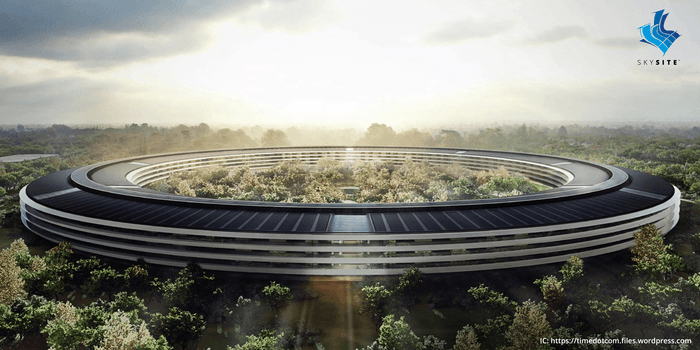Apple Park, or the Spaceship, as Apple’s new headquarters in Cupertino, CA is commonly referred to, recently opened to much fanfare. Much has been written, good and bad, about Steve Job’s last passion project. Every detail of the flashy $5 billion project has been thought of, down to the custom-built door handles.
So, it’s no surprise that the campus has been designed to be uncommonly environmentally friendly. In fact, CEO Tim Cook boasts that it could be the “greenest building in the world.”
From the beginning, Steve Job’s dream campus, was built to reflect Apple’s values, both for technology and the environment. The project has converted a sea of asphalt into a 175-acre campus powered by 100% renewable energy with most of the power for the facilities coming from an on-site low carbon central plant. The building also features one of the largest solar installations in the world, nearly every inch of the roof will generate electricity.
But that’s just the beginning of the green initiatives for Apple Park, these are just some of the measures being implemented:
- The Spaceship is the world’s largest naturally ventilated building and won’t require heating or AC for nine months of the year.
- It contains about 4,300 hollow concrete slabs which helps the building stay cool (according to Popular Science).
- 7,000 trees will be planted around the campus, with fruits and vegetables from some of trees and plants being served in the employee cafeteria.
- The landscaping, with the help a leading arborist from Stanford University, will restore some of the indigenous plant life.
- 1,000 bikes will be kept on the site and available to staff to get around the campus.
- Ride sharing will be encouraged as there are thousands fewer (by design) parking spots than the 12,000 employees that will work their daily.
- Recycled water will be used, with 13,300 ft. of pipeline to share the supply with the City of Cupertino.
However, despite its environmentally friendly build, the campus missed an opportunity to be part of the surrounding community and create a pedestrian environment that would allow people not to drive. By choosing the site in Cupertino, a suburb, it obligated most of its employees to drive to work alone. This contrasts with Google, who plans to build a campus in a downtown San Jose, CA, neighborhood that is adjacent to the train and will have plenty of living spaces within walking distance. Can a campus truly be considered green if it is not part of neighborhood and if it forces its employees to drive to work?
There is also the matter of the $5 billion price tag. Despite aiming to be self-sufficient and earth-friendly, Apple’s exacting demands when it comes to design ensured the materials used in the construction were without a doubt top of the line. Given Apple Park’s price tag, are these efforts reasonable for the average company? According to a study by Structure Tone “cost is overwhelmingly still seen as the number one barrier to adopting truly sustainable building practices.”
Despite some negative critique, this green initiative is truly impressive and shows that Apple is not only a pioneer in tech, but is an innovator in sustainable buildings and environments that promote employee wellness (did we mention the 100,000-sq. ft. fitness center).
Now, if only they would complete their green process and go paperless with SKYSITE for their construction, facilities and archival document management . . .





